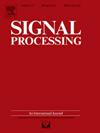Optimal estimation of the canonical polyadic decomposition from low-rank tensor trains
IF 3.4
2区 工程技术
Q2 ENGINEERING, ELECTRICAL & ELECTRONIC
引用次数: 0
Abstract
Tensor factorization has been steadily used to represent high-dimensional data. In particular, the canonical polyadic decomposition (CPD) is very appreciated for its remarkable uniqueness properties. However, computing the high-order CPD is challenging: numerical issues and high needs for storage and processing can make algorithms diverge. Furthermore, the recovery of the CP factors is an ill-posed problem. One way to circumvent this limitation is to exploit the equivalence between the CPD and the Tensor Train Decomposition (TTD). This paper formulates the CPD as a dimension reduction using a TTD followed by a global marginally convex optimization problem. This global optimization scheme estimates the CP factors with minimal error. The resulting approach, Dimensionality Reduction, joint Estimation of the Ambiguity Matrices and the CP FACtors (DREAMFAC), relies on a block-coordinate descent that reaches a first-order stationary point when estimating the CP factors. DREAMFAC is also shown to be an optimal estimator that reaches the corresponding constrained Cramér–Rao bound. It therefore appears as a state-of-the-art solution to estimate the best rank- CPD of a tensor (when it exists). Its performance is illustrated on the problem of parameter estimation in a dual-polarized MIMO system. Numerical experiments show the excellent practical performance of DREAMFAC, even with very low SNR.
求助全文
约1分钟内获得全文
求助全文
来源期刊

Signal Processing
工程技术-工程:电子与电气
CiteScore
9.20
自引率
9.10%
发文量
309
审稿时长
41 days
期刊介绍:
Signal Processing incorporates all aspects of the theory and practice of signal processing. It features original research work, tutorial and review articles, and accounts of practical developments. It is intended for a rapid dissemination of knowledge and experience to engineers and scientists working in the research, development or practical application of signal processing.
Subject areas covered by the journal include: Signal Theory; Stochastic Processes; Detection and Estimation; Spectral Analysis; Filtering; Signal Processing Systems; Software Developments; Image Processing; Pattern Recognition; Optical Signal Processing; Digital Signal Processing; Multi-dimensional Signal Processing; Communication Signal Processing; Biomedical Signal Processing; Geophysical and Astrophysical Signal Processing; Earth Resources Signal Processing; Acoustic and Vibration Signal Processing; Data Processing; Remote Sensing; Signal Processing Technology; Radar Signal Processing; Sonar Signal Processing; Industrial Applications; New Applications.
 求助内容:
求助内容: 应助结果提醒方式:
应助结果提醒方式:


